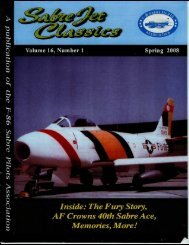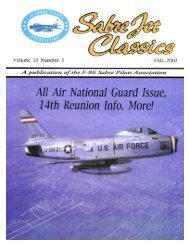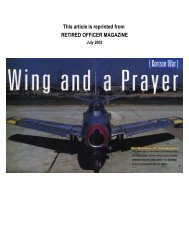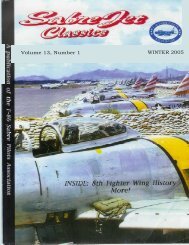Volume 8 Number 1 Spring 2000 - Sabre Pilots Association
Volume 8 Number 1 Spring 2000 - Sabre Pilots Association
Volume 8 Number 1 Spring 2000 - Sabre Pilots Association
You also want an ePaper? Increase the reach of your titles
YUMPU automatically turns print PDFs into web optimized ePapers that Google loves.
A new F-86K assigned to EC 1/13 over a typical undercast<br />
usually found over eastern France. Weather was always<br />
a problem for NATO units in Europe, which is the reason<br />
that many NATO air forces chose the all-weather F-86K<br />
as their primary air defense system.<br />
"About the same time as the simulator program began<br />
to end, the first of our brand new Fiat-built F-86Ks began<br />
to arrive at Lahr AB. This is where the exciting part<br />
began - flying that marvelous aircraft. I made my first<br />
flight in the F-86K on 11 February 1957.<br />
"It was about that time that we moved from Lahr AB,<br />
West Germany, to the eastern part of France and a new<br />
airbase - Colmar Myenheim. Here we received the rest<br />
of the 60 F-86Ks and we split into the two operational<br />
squadrons, EC 1/13 and 2/13."<br />
"Most of our training missions in the F-86K at this time<br />
were aircraft identification in both daylight and nighttime<br />
conditions, and in all types of weather. Often, we<br />
would take off from Colmar, make a training intercept,<br />
then land at either a U.S. Air Force or RCAF base in West<br />
Germany, where we would refuel, then take off for another<br />
intercept before heading for home at Colmar."<br />
"Once we became fully combat operational, we would<br />
sit alert at one end of the runway at Colmar. The alert<br />
pilots lived in tents both during summer and winter.<br />
(We had some USAF F-86D pilots visit us, standing alert<br />
beside our F-86Ks and living with us in tents during the<br />
winter. We didn't see them again so we knew it was very<br />
uncomfortable.)"<br />
"I recall that we scrambled several times on one Czechoslovakian<br />
IL-18 airliner that was flying from Paris back<br />
towards the east. The guy would never follow the flight<br />
plan, and we suspected he was taking infrared photos<br />
of restricted areas. But he knew where he was supposed<br />
to be right away when he heard us approaching for a<br />
high-angle identification pass."<br />
"I was also scrambled on one mission to help a pair of<br />
US F-101A Voodoo fighters that had an emergency at<br />
high altitude above a very thick undercast. They joined<br />
up on each side of me and we let down through the<br />
cloud deck for a landing at Solingen AB in West Germany.<br />
(They sent us a box of whiskey, thank you very<br />
much!) Such was our life in EC-1/13 with the F-86Ks."<br />
11<br />
The K used the same APG-36 radar as the F-86D, but with<br />
the simpler MG-4 FCS. (credit - J.M. Deudonne)<br />
(above) An F-86K from EC 1/13 coming in for a landing<br />
at Mayenheim AB, Germany in late 1961. EC 1/13 <strong>Sabre</strong>s<br />
carried code letters beginning with "Cr. (below) This F-<br />
86K was assigned to EC 2/13 as denoted by the code<br />
letter "P" on the nose. EC 2/13 was the second squadron<br />
to receive F-86Ks in early 1958, and were based at Lahr<br />
AB, Germany alongside EC 1/13. (credit - Werner Gysin<br />
R J.M. Deudonne)









